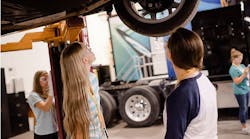Women are underrepresented and underutilized in the manufacturing workforce. Despite making up about half of all workers overall, they account for less than one-third of manufacturing workers. Compounding this problem and creating an urgency around getting more women into manufacturing is the fact that plenty of jobs are out there ready to be filled, as manufacturers currently face a workforce crisis.
According to the National Association of Manufacturers’ quarterly outlook survey, for the past six consecutive quarters, manufacturers’ top concern has been the inability to attract and retain a quality workforce. In fact, there are about half a million jobs open in manufacturing right now, and we expect to need to fill about 4.6 million manufacturing jobs over the next decade. A study by Deloitte and The Manufacturing Institute—the education and workforce partner of NAM and the organization I lead—finds that more than half of those job openings could go unfilled unless we attract, educate and retain more workers to fill them.
Bridging that divide will mean reshaping the way people think about jobs in manufacturing, educating them to the types of jobs that are available and helping them get the qualifications necessary to fill them. Put simply, the manufacturing industry is in a state of reinvention, and exciting, educating and empowering women will be critical to the future of the industry. Women represent one of the largest pools of untapped talent for manufacturers, and closing manufacturing’s gender gap is key to closing the skills gap that has limited businesses’ ability to evolve and expand. In addition to filling open positions, though, research shows that gender diversity benefits manufacturing firms by creating a culture that improves their ability to innovate and grow. And more than just bottom lines, women in manufacturing are building meaningful careers—and quite literally building the future.
The Manufacturing Institute is dedicated to building the manufacturing workforce of today and inspiring the manufacturing workforce of tomorrow. Our STEP Ahead Women’s Initiative is a program aimed to honor and promote the role of women in science, technology, engineering and production. Our STEP Forward events around the country over the course of the year work to educate manufacturers on attracting and retaining female employees, and our annual STEP Ahead Awards provide an opportunity to honor the accomplishments of exceptional women in manufacturing and arm them with the tools to pay it forward to inspire and mentor the next generation.
This week is our marquee program: the annual STEP Ahead Awards in Washington, D.C. This year’s 100 Honorees are women being recognized for their extraordinary careers and accomplishments, and the 30 Emerging Leaders, our “30 under 30,” are being celebrated and encouraged to be the next generation of female leaders. From mechatronics engineers to senior directors of information technology, vice presidents of research and development and innovation to presidents and CEOs, these women are building the future and breaking barriers. They’re blazing new trails and showing others the way. We believe it is incredibly important to shine a light on the accomplishments of women in the manufacturing industry to inspire others to join them.
Whether developing new productivity measures that are implemented on shop floors worldwide, creating new medicine that saves and transforms lives, helping lead communities back after natural disasters and more, the women we are celebrating through the STEP Ahead Awards this week have accomplished so much, but their biggest achievement will be the multitudes of women they’ve inspired in their wake.
Each woman we recognize for her success in manufacturing has her own story, but together—and with the help of efforts to amplify their message—they are creating a narrative. Individually, their achievements shape their careers, but collectively, and with the women they inspire, they can reshape their industries. That’s why each participant in the STEP Ahead Awards commits to paying it forward and inspiring the next generation of women in manufacturing.
These women are leading the way through their work in developing solutions to some of the greatest challenges facing the world around them—and by inspiring and encouraging more women to join the manufacturing workforce, they themselves are also a part of the solution to the industry’s workforce needs. Since the dawn of Rosie the Riveter in popular culture and the droves of women who descended upon shop floors during World War II, women haven’t just been a part of the progress of manufacturing in America; they have led the way.




